第八章社会语言学
- 格式:doc
- 大小:37.50 KB
- 文档页数:10
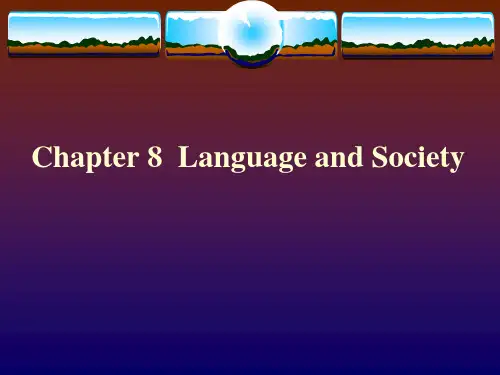
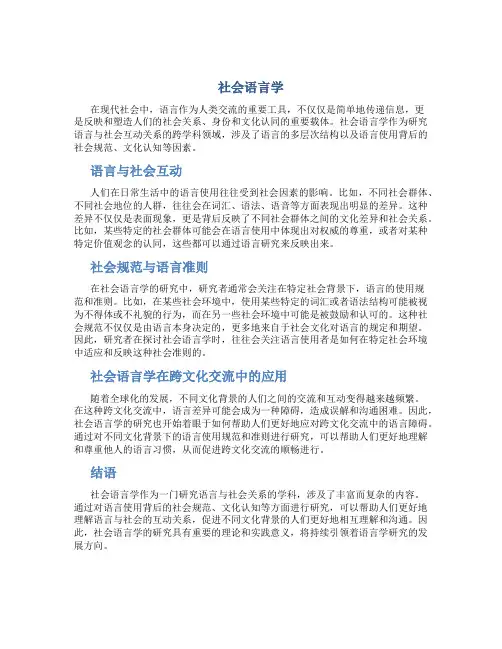
社会语言学在现代社会中,语言作为人类交流的重要工具,不仅仅是简单地传递信息,更是反映和塑造人们的社会关系、身份和文化认同的重要载体。
社会语言学作为研究语言与社会互动关系的跨学科领域,涉及了语言的多层次结构以及语言使用背后的社会规范、文化认知等因素。
语言与社会互动人们在日常生活中的语言使用往往受到社会因素的影响。
比如,不同社会群体、不同社会地位的人群,往往会在词汇、语法、语音等方面表现出明显的差异。
这种差异不仅仅是表面现象,更是背后反映了不同社会群体之间的文化差异和社会关系。
比如,某些特定的社会群体可能会在语言使用中体现出对权威的尊重,或者对某种特定价值观念的认同,这些都可以通过语言研究来反映出来。
社会规范与语言准则在社会语言学的研究中,研究者通常会关注在特定社会背景下,语言的使用规范和准则。
比如,在某些社会环境中,使用某些特定的词汇或者语法结构可能被视为不得体或不礼貌的行为,而在另一些社会环境中可能是被鼓励和认可的。
这种社会规范不仅仅是由语言本身决定的,更多地来自于社会文化对语言的规定和期望。
因此,研究者在探讨社会语言学时,往往会关注语言使用者是如何在特定社会环境中适应和反映这种社会准则的。
社会语言学在跨文化交流中的应用随着全球化的发展,不同文化背景的人们之间的交流和互动变得越来越频繁。
在这种跨文化交流中,语言差异可能会成为一种障碍,造成误解和沟通困难。
因此,社会语言学的研究也开始着眼于如何帮助人们更好地应对跨文化交流中的语言障碍。
通过对不同文化背景下的语言使用规范和准则进行研究,可以帮助人们更好地理解和尊重他人的语言习惯,从而促进跨文化交流的顺畅进行。
结语社会语言学作为一门研究语言与社会关系的学科,涉及了丰富而复杂的内容。
通过对语言使用背后的社会规范、文化认知等方面进行研究,可以帮助人们更好地理解语言与社会的互动关系,促进不同文化背景的人们更好地相互理解和沟通。
因此,社会语言学的研究具有重要的理论和实践意义,将持续引领着语言学研究的发展方向。

英语语言学概论第八章笔记Chapter 8 Socio-linguistics 社会语言学1.What is socio-linguistics? 什么是社会语言学?Sociolinguistics is the sub-discipline of linguistics that studies language in social contexts.社会语言学是语言学的一个分支,它研究社会环境中的语言。
nguage variation 语言变异a)S peech community 言语社区In sociolinguistic studies, speakers are treated as members of social groups. The social group isolated for any given study is called speech community. A speech community thus defined as a group of people who form a community (which may have as few members as a family or as many member as a country), and share the same language or a particular variety of language. The important characteristic of a speech community is that the members of the group must, in some reasonable way, interact linguistically with other members of the community. They may share closely related language varieties, as well as attitudes toward linguistic norms.社会语言学研究中,说话者被当作是社会群体的成员。


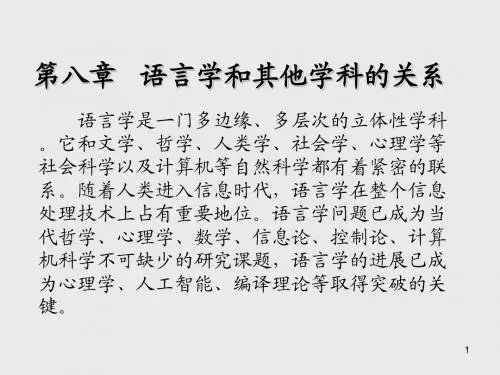

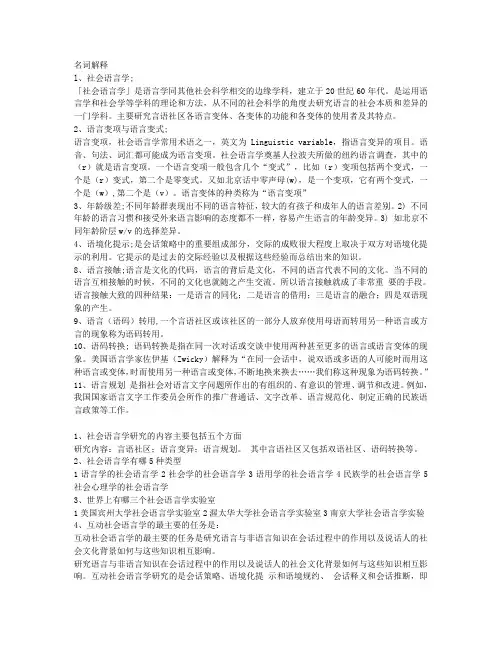
名词解释l、社会语言学;「社会语言学」是语言学同其他社会科学相交的边缘学科,建立于20世纪60年代。
是运用语言学和社会学等学科的理论和方法,从不同的社会科学的角度去研究语言的社会本质和差异的一门学科。
主要研究言语社区各语言变体、各变体的功能和各变体的使用者及其特点。
2、语言变项与语言变式;语言变项,社会语言学常用术语之一,英文为Linguistic variable,指语言变异的项目。
语音、句法、词汇都可能成为语言变项。
社会语言学奠基人拉波夫所做的纽约语言调查,其中的(r)就是语言变项。
一个语言变项一般包含几个“变式”,比如(r)变项包括两个变式,一个是(r)变式,第二个是零变式。
又如北京话中零声母(w),是一个变项,它有两个变式,一个是(w),第二个是(v)。
语言变体的种类称为“语言变项”3、年龄级差;不同年龄群表现出不同的语言特征,较大的有孩子和成年人的语言差别。
2) 不同年龄的语言习惯和接受外来语言影响的态度都不一样,容易产生语言的年龄变异。
3) 如北京不同年龄阶层w/v的选择差异。
4、语境化提示;是会话策略中的重要组成部分,交际的成败很大程度上取决于双方对语境化提示的利用。
它提示的是过去的交际经验以及根据这些经验而总结出来的知识。
8、语言接触;语言是文化的代码,语言的背后是文化,不同的语言代表不同的文化。
当不同的语言互相接触的时候,不同的文化也就随之产生交流。
所以语言接触就成了非常重要的手段。
语言接触大致的四种结果:一是语言的同化;二是语言的借用;三是语言的融合;四是双语现象的产生。
9、语言(语码)转用,一个言语社区或该社区的一部分人放弃使用母语而转用另一种语言或方言的现象称为语码转用。
10、语码转换; 语码转换是指在同一次对话或交谈中使用两种甚至更多的语言或语言变体的现象。
美国语言学家佐伊基(Zwicky)解释为“在同一会话中,说双语或多语的人可能时而用这种语言或变体,时而使用另一种语言或变体,不断地换来换去……我们称这种现象为语码转换。

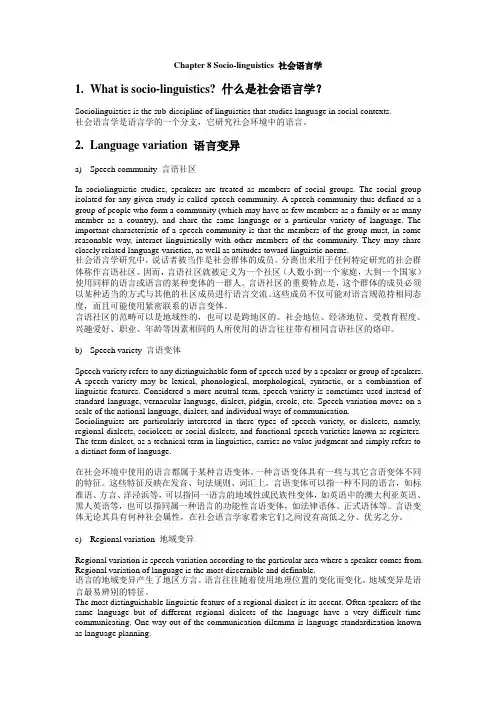
Chapter 8 Socio-linguistics 社会语言学1.What is socio-linguistics? 什么是社会语言学?Sociolinguistics is the sub-discipline of linguistics that studies language in social contexts.社会语言学是语言学的一个分支,它研究社会环境中的语言。
nguage variation 语言变异a)Speech community 言语社区In sociolinguistic studies, speakers are treated as members of social groups. The social group isolated for any given study is called speech community. A speech community thus defined as a group of people who form a community (which may have as few members as a family or as many member as a country), and share the same language or a particular variety of language. The important characteristic of a speech community is that the members of the group must, in some reasonable way, interact linguistically with other members of the community. They may share closely related language varieties, as well as attitudes toward linguistic norms.社会语言学研究中,说话者被当作是社会群体的成员。

社会语言学社会语言学是研究语言与社会之间相互影响关系的学科领域,旨在探究语言如何反映和塑造社会实践、文化认知以及个体身份的。
本文将从语言习得、语言变体、社会语言变迁以及语言政治等方面阐述社会语言学的重要性和研究内容。
语言习得社会语言学关注语言习得在社会文化背景下的影响。
语言习得不仅是个体学习语言的过程,也是对社会文化的认知和适应过程。
社会语言学研究了不同社会文化背景下语言习得的差异,以及社会因素如家庭、学校、媒体等对语言习得的影响。
语言变体语言变体指的是由不同社会群体使用的语言形式或说话方式。
社会语言学研究了不同社会群体之间的语言差异,包括社会阶层、地区、年龄、性别等因素导致的语言变体。
这些语言变体反映了社会文化的特征,也影响着个体在社会交流中的地位和角色。
社会语言变迁社会语言学关注社会语言的变迁和演变。
随着社会文化的不断发展,语言也会随之改变,包括词汇的加入、语法结构的变化以及语音语调的演变。
社会语言学研究了这些变迁的原因和影响,揭示了语言与社会之间的密切关联。
语言政治语言政治是指政府、组织或个人通过语言运用来实现政治目标或控制社会。
社会语言学研究了语言政治在社会生活中的作用,包括语言政策对多语使用、官方语言地位以及民族认同的影响。
语言政治不仅是政治领域的重要议题,也反映了不同群体之间的社会关系和权力结构。
综上所述,社会语言学作为语言学的一个重要分支,深入探讨了语言与社会之间复杂的相互作用关系。
通过研究语言在社会文化背景下的使用和变化,社会语言学为我们理解语言的本质以及社会现象提供了新的视角和方法。
在日益全球化和多元文化的背景下,社会语言学的研究具有重要的理论和实践意义,有助于促进不同社会群体之间的交流和理解。
Language and Society13073080 刘颖Sociolinguistics is the sub-field of linguistics that studies the relation between the language and society, between the use of language and the social structures in which the users of the language live. There are many indications of the inter-relationship between language and society. One of them are that while language is principally used to communicate meaning, it is used to established and maintain social relationships. Another indication is that the users of the same language in a sense all speak differently. Then to some extent, language, especially the structure of its lexicon, reflects both the physical and the social environment of a society. As a social phenomenon, language is closely related the structure of the society in which it is used, and the evaluation of a language form is entirely social.In sociolinguistic studies, speakers are regarded as member of social groups. The social group that is singled out for any special study is called the speech community. The term speech community, or linguistic community, is widely used by sociolinguistics to refer to a community based on language. Within a speech community there exist various social groups. Speech variety, or linguistic variety, refers to any distinguishable form of speech used by a speaker or a group of speakers. In sociolinguistics studies three types of speech variety are of special interest, i.e. regional dialects, sociolects, and registers.The study of the relationship between the language and society can be approached in two ways. We can look at society as a whole and consider how it reflects the social differentiations. The other approach is to look at society from the point of view of individual members of the society. The former is sometimes refers to as micro-sociolinguistics or the sociology of language, and the latter a micro-sociolinguistics or sociolinguistics proper. The notion of a language is not monolithic and there exist types or varieties of the same language. Varieties related to the user are normally known as dialects and varieties related to use as registers.The striking variation of age is well illustrated by children language as it develops, regarding all levels of language from phonology to vocabulary and syntax. Age divisions are 2, 5 and 12. Variation in language use is also associated with the sex of individual speakers. Sex-preferred differentiation in terms of speech varieties of males and females exists in all natural languages across the world. Women in many countries are more status-conscious than men, and therefore more aware of the social significance of linguistic variables. Language reflects obvious sex prejudice. The use of sexist language does not mean that it is the language that is sexist but rather the social attitude connoted in the language is sexist. The meanings of some English words really echo the realtraditional roles of men and women in history. As social attitude towards women change in recent years, linguistic changes in many languages are taking place that reflect the feminist movement and the growing awareness that language and language use mirror social attitudes and reinforce stereotypes and bias. The change can be sensed in the morphological variation. Linguistic forms associating sexist prejudice are always intentionally avoided in communication. Gender varieties are caused by society rather than by evolution.Register, in a restricted sense, refers to the variety of language related to one’s occupation. Field of discourse: What is going on: to the area of operation of the language activity. It is concerned with the purpose (why) and subject matter (about what) of communication. It can be either technical or non-technical. Tenor of discourse: the role of relationship in the situation in question: who are the participants in the communication and in what relationship they stand to each other. (Customer-shop-assistant, teacher-student, etc.). Mode of discourse: the means of communication. It is concerned with how communication is carried out. (oral, written, on the line…)Formality refers to the degree of formality in different occasions and reflects the relationship and conversations. According to Martin Joos, there are five stages of formality, namely, intimate, casual, consultative, formal and frozen. The standard variety is a superimposed, socially prestigious dialect of a language. It is the language employed by the government and the judiciary system, used by the mass media, and taught in educational institutions, including school settings where the language is taught as a foreign or second language. The standard language serves as a yard stick against which all other varieties are measured. Features of the standard variety, it is based on a selected variety of the language; usually it is the local speech of an area which is considered the nation’s political and commercial center. It is not a dialect a child acquires naturally like his regional dialect, rather it is taught and learnt in schools. It has some special functions and it the language used on any formal occasions.A pidgin is a special language variety that mixes or blends languages and it is used by people who speak different languages for restricted purposes such as trading. Limited vocabulary and much reduced grammatical structure. When a pidgin has become the primary language of a speech community, and is acquired by the children of that speech community as their native language, it is said to have become a Creole. It is through mistakes and compromises that pidgins develop themselves. A creole is often defined as a pidgin that has become the first language of a new generation of speakers. After a pidgin is creolized, there is another stage of development in which the speakers of the creole may be introduced to the standard language. A post-creole continuum: standard language mayplay the role at one end to fulfill certain social obligation and the creole may function at another end in its specific field. What happens to regional dialect.Diglossia refers to two varieties of a language exist side by side throughout the community, with each having a definite role to play. It is used to describe any stable linguistic situation, in which there exists a strict functional differentiation between a “high” variety and a “low”variety. In some speech communities, two languages are used side by side with each having a different role to play; and language switching occurs when the situation changes. This constitutes the situation of Bilingualism. Diglossia usually describes a situation in which two different varieties of language co-exist in a speech community, each with a distinct range of purely social function and appropriate for certain situations. Diglossia is a not a universal phenomenon. It, for example, hardly exists in English-speaking countries such as Britain and United States. According to Ferguson, diglossia refers to a sociolinguistic situation similar to bilingualism. But instead of two different languages, in a diglossia situation two varieties of a language exist side by side throughout the community, with each having a definite role to play. They estimated that there are more than 6000 languages spoken throughout the world. Multilingualism is mainly created by three reasons: migration, conquest and intermarriage.Welcome !!! 欢迎您的下载,资料仅供参考!。
Language and Society刘颖Sociolinguistics is the sub-field of linguistics that studies the relation between the language and society, between the use of language and the social structures in which the users of the language live. There are many indications of the inter-relationship between language and society. One of them are that while language is principally used to communicate meaning, it is used to established and maintain social relationships. Another indication is that the users of the same language in a sense all speak differently. Then to some extent, language, especially the structure of its lexicon, reflects both the physical and the social environment of a society. As a social phenomenon, language is closely related the structure of the society in which it is used, and the evaluation of a language form is entirely social.In sociolinguistic studies, speakers are regarded as member of social groups. The social group that is singled out for any special study is called the speech community. The term speech community, or linguistic community, is widely used by sociolinguistics to refer to a community based on language. Within a speech community there exist various social groups. Speech variety, or linguistic variety, refers to any distinguishable form of speech used by a speaker or a group of speakers. In sociolinguistics studies three types of speech variety are of special interest, . regional dialects, sociolects, and registers.The study of the relationship between the language and society can be approached in two ways. We can look at society as a whole and consider how it reflects the social differentiations. The other approach is to look at society from the point of view of individual members of the society.The former is sometimes refers to as micro-sociolinguistics or the sociology of language, and the latter a micro-sociolinguistics or sociolinguistics proper. The notion of a language is not monolithic and there exist types or varieties of the same language. Varieties related to the user are normally known as dialects and varieties related to use as registers.The striking variation of age is well illustrated by children language as it develops, regarding all levels of language from phonology to vocabulary and syntax. Age divisions are 2, 5 and 12. Variation in language use is also associated with the sex of individual speakers. Sex-preferred differentiation in terms of speech varieties of males and females exists in all natural languages across the world. Women in many countries are more status-conscious than men, and therefore more aware of the social significance of linguistic variables. Language reflects obvious sex prejudice. The use of sexist language does not mean that it is the language that is sexist but rather the social attitude connoted in the language is sexist. The meanings of some English words really echo the real traditional roles of men and women in history. As social attitude towards women change in recent years, linguistic changes in many languages are taking place that reflect the feminist movement and the growing awareness that language and language use mirror social attitudes and reinforce stereotypes and bias. The change can be sensed in the morphological variation. Linguistic forms associating sexist prejudice are always intentionally avoided in communication. Gender varieties are caused by society rather than by evolution.Register, in a restricted sense, refers to the variety of language related to one’s occupation. Field of discourse: What is going on: to the areaof operation of the language activity. It is concerned with the purpose (why) and subject matter (about what) of communication. It can be either technical or non-technical. Tenor of discourse: the role of relationship in the situation in question: who are the participants in the communication and in what relationship they stand to each other. (Customer-shop-assistant, teacher-student, etc.). Mode of discourse: the means of communication. It is concerned with how communication is carried out. (oral, written, on the li ne…)Formality refers to the degree of formality in different occasions and reflects the relationship and conversations. According to Martin Joos, there are five stages of formality, namely, intimate, casual, consultative, formal and frozen. The standard variety is a superimposed, socially prestigious dialect of a language. It is the language employed by the government and the judiciary system, used by the mass media, and taught in educational institutions, including school settings where the language is taught as a foreign or second language. The standard language serves as a yard stick against which all other varieties are measured. Features of the standard variety, it is based on a selected variety of the language; usually it is the local speech of an area which is considered the nation’s political and commercial center. It is not a dialect a child acquires naturally like his regional dialect, rather it is taught and learnt in schools. It has some special functions and it the language used on any formal occasions.A pidgin is a special language variety that mixes or blends languages and it is used by people who speak different languages for restricted purposes such as trading. Limited vocabulary and much reduced grammatical structure. When a pidgin has become the primary language of a speechcommunity, and is acquired by the children of that speech community as their native language, it is said to have become a Creole. It is through mistakes and compromises that pidgins develop themselves. A creole is often defined as a pidgin that has become the first language of a new generation of speakers. After a pidgin is creolized, there is another stage of development in which the speakers of the creole may be introduced to the standard language. A post-creole continuum: standard language may play the role at one end to fulfill certain social obligation and the creole may function at another end in its specific field. What happens to regional dialect.Diglossia refers to two varieties of a language exist side by side throughout the community, with each having a definite role to play. It is used to describe any stable linguistic situation, in which there exists a strict functional differentiation between a “high” variety and a “low” variety. In some speech communities, t wo languages are used side by side with each having a different role to play; and language switching occurs when the situation changes. This constitutes the situation of Bilingualism. Diglossia usually describes a situation in which two different varieties of language co-exist in a speech community, each with a distinct range of purely social function and appropriate for certain situations. Diglossia is a not a universal phenomenon. It, for example, hardly exists in English-speaking countries such as Britain and United States. According to Ferguson, diglossia refers to a sociolinguistic situation similar to bilingualism. But instead of two different languages, in a diglossia situation two varieties of a language exist side by side throughout the community, with each having a definite role to play. They estimated that there are more than 6000 languages spoken throughout theworld. Multilingualism is mainly created by three reasons: migration, conquest and intermarriage.。
社会语言学社会语言学是语言学中的重要研究领域或之一,它是一门研究语言与社会的关系的学问。
语言社会相互影响。
首先社会对语言的影响,具体指语言的变异、变体和语言使用习惯上的差异。
其次是语言对社会的影响,具体指语言的社会功能。
而社会对语言的影响是社会语言学的研究重点。
语言是一种社会现象,在社会生活中起着极其重要的作用,而社会对语言产生巨大的影响。
人们的阶级出身、社会地位、接受的教育、从事的职业、再加上各自年龄、性别、民族等各方面有很大的不同,所以使用的语言就会有差异,这就形成了语言的变异和变体。
语言的变异和变体反映在语音、语调、语法和语汇的差别上,也反映道语言使用习惯的差别上。
正是因为这一点,有的语言学家用下面一句话来概括社会语言学:社会语言学的任务在于描述“语言和社会结构的共变”。
(William Bright,1964) 后来,美国的另一位社会语言学家Nessa Wolson (1983)用一句话来概括社会语言学的范围:Who says what to whom, when and how.这句话概括了社会语言学的要素:what 代表语言部分,how代表说话的方式方法,who、whom和when代表社会变量,即说话人和听话人在什么时候或什么场合讲的话。
综上所述,不管语言学家如何界说社会语言学,作为一门重要的学科领域,它主要研究语言的变异、变体、语言使用习惯上的差异,以及造成这些变异、变体及差异的社会文化因素。
本系社会语言学方向开设的课程有“社会语言学导论”、“语言与社会”、“跨文化交际”、“文体学”、“统计学”等,系统地介绍社会语言学中的各种概念及理论,为学生打下坚实的理论基础,使学生对社会语言学有系统的认识,并培养学生初步进行实地调查的能力。
Sociolinguistics is the study of language in relation to society. Sociolinguistics is concerned with investigating the relationships between language and society with the goal being a better understanding of the structure of language and of how languages function in communication. Coulmas (1997) says that sociolinguistics (micro-sociolinguistics) investigates how social structure influences the way people talk and how language varieties and patterns of use correlate with social attributes such as class, sex, and age.Language is closely intertwined with society, and it is impossible to understand one without the knowledge of the other. Therefore, we must look into various aspects of the possible relationships between language and society. There is no human society that does not depend upon, is not shaped by, and does not itself shape language. The relationship between language and society can be interestingly reflected in the ways people use language in social interaction, actually in the whole stuff of everyday life; how you talk to your friends, family, and teachers, as well as to storekeepers and strangers——everyone you meet in the course of a day——and why you talk as you do and they talk as they do. Almost all of our contact with family and friends, and much of our contact with strangers, involves speaking. Much of such speaking is strongly governed by rules, rules that dictate others with language, and they manipulate us, often without either party being at all aware of the manipulation. A communicatively competent person must know when it is appropriate to open a conversation and how, what topics are appropriate to particular speech events, whichforms of address are to be used to whom and in which situations, and how such speech acts as greetings, complements, apologies, invitations and complaints are to be given, interpreted and responded to.Relevantly concerned with both language and society are also apparently trivial matters, with the talk on street corners as well as in the classroom, the things that people do when they want to talk and the ways they signal that they are listening. Even matters like where you choose to sit in a cafeteria or at a meeting, or the amount of space you want between you and someone else when you are talking, concern the sociolinguist.语言、文化与翻译当代翻译研究已不单纯限于语言方面,越来越多的翻译工作者开始把目光投向文化与翻译之间的关系;因此,翻译不仅需要进行不同语言之间的转换工作,而且还要关注文化因素在翻译中起的作用。
第八章社会语言学1.语言变异语言的使用属于社会现象,语言的使用会因言语社区、地域、社会团体、甚至个人的不同而不同。
社会语言学(sociolinguistics)是把语言置于社会环境中来研究语言,从而揭示在不同的社会语境中语言变化的本质特征和社会意义。
1.1言语社区(speech community)言语社区可以定义为构成一个社团的一群人,他们具有相同的语言或具有同一语言中某一特定的变体。
言语社区的一个重要特点是同一言语社区的人使用同一语言或同一语言中的不同的变体进行交际,而且他们对他们所使用的语言的规范具有类似的态度。
社会地位、经济地位、受教育程度、职业、年龄等因素不同的人所使用的语言往往带有他们各自言语社区的烙印。
1.2言语变体(speech variety)言语变体(speech variety),有称之为语言变体,是语言使用者所使用的具有一定区别性特征的变体。
这些不同的特征主要反映在发音、句法规则或词汇上。
言语变体作为一种中性词语可以指标准语(standard language)、方言(dialect)、洋径浜语(pidgin)、克里奥尔语(creole)等,可以指同一语言的地域性或民族性变体,如英语中的澳大利亚英语、黑人英语等,也可以指同属一种语言的功能性言语变体,如法律语体等。
社会语言学家尤其是对地域变体(又称地域方言)、社会变体(又称社会方言)和功能变体(又称语域)感兴趣。
言语变体无论其具有何种社会属性,在社会语言学家看来它们之间没有高低之分、优劣之别,因为它们都是体系的。
1.3地域变异(regional variation)地理障碍如高山,海洋,空间的距离等是造成语言地域变异的主要原因,除此之外,对自己地方语的“忠诚”以及对语言变化的抵触情绪也是形成地域方言的原因。
虽然语言的地域变异反映在发音、词汇和句法上,但是语言地域性变异的最显著的特征是地域口音(accent)。
由于地域变体的存在给跨地区的交际造成障碍,语言规划(language planning)应运而生。
第八章社会语言学1.语言变异语言的使用属于社会现象,语言的使用会因言语社区、地域、社会团体、甚至个人的不同而不同。
社会语言学(sociolinguistics)是把语言置于社会环境中来研究语言,从而揭示在不同的社会语境中语言变化的本质特征和社会意义。
1.1言语社区(speech community)言语社区可以定义为构成一个社团的一群人,他们具有相同的语言或具有同一语言中某一特定的变体。
言语社区的一个重要特点是同一言语社区的人使用同一语言或同一语言中的不同的变体进行交际,而且他们对他们所使用的语言的规范具有类似的态度。
社会地位、经济地位、受教育程度、职业、年龄等因素不同的人所使用的语言往往带有他们各自言语社区的烙印。
1.2言语变体(speech variety)言语变体(speech variety),有称之为语言变体,是语言使用者所使用的具有一定区别性特征的变体。
这些不同的特征主要反映在发音、句法规则或词汇上。
言语变体作为一种中性词语可以指标准语(standard language)、方言(dialect)、洋径浜语(pidgin)、克里奥尔语(creole)等,可以指同一语言的地域性或民族性变体,如英语中的澳大利亚英语、黑人英语等,也可以指同属一种语言的功能性言语变体,如法律语体等。
社会语言学家尤其是对地域变体(又称地域方言)、社会变体(又称社会方言)和功能变体(又称语域)感兴趣。
言语变体无论其具有何种社会属性,在社会语言学家看来它们之间没有高低之分、优劣之别,因为它们都是体系的。
1.3地域变异(regional variation)地理障碍如高山,海洋,空间的距离等是造成语言地域变异的主要原因,除此之外,对自己地方语的“忠诚”以及对语言变化的抵触情绪也是形成地域方言的原因。
虽然语言的地域变异反映在发音、词汇和句法上,但是语言地域性变异的最显著的特征是地域口音(accent)。
由于地域变体的存在给跨地区的交际造成障碍,语言规划(language planning)应运而生。
语言规划是政府行为。
政府常常选择某一特定的言语变体,对这种变体在语音、句法和词汇上进行语言标准化规划,并在社会中进行推广使用。
1.4.社会变异语言的社会变异产生了社会方言(sociolect)。
使用同一地方方言的人在说话时,他们的地方方言中会有一些由于社会因素造成的言语特征,这些言语特征与地域差异没有关系。
换句话说,不同的社会地位、经济地位、学历、职业、年龄、性别等社会因素会导致不同的人在语言使用上的差异。
生活在同一地区的人,虽然使用同一种地方方言,但是他们也会有意或无意选择符合他们社会身份的言语形式进行交际。
1.5 文体变异(stylistic variation)语言的文体变异是指语言使用者在说话或写作中的语用变体。
一个人的文体有时非常正式,有时比较随便,有时甚至不登大雅之堂。
决定使用某种文体的因素包括交际的场合、交际双方的身分或关系、交际的地点、交谈的题目等。
文体的差异主要是通过不同的发音、不同的语法结构或不同的词汇选择来实现的。
文体不仅可以指一个人对言语的习惯性使用,也可以指具有相同职业背景的人所共有的言语使用特征。
1.6 个人言语变异(idiolectal variation)一个人的语言使用不是始终如一的。
操同一语言的两个人不可能在使用这一语言时是完全一样的。
他们对同一语言或变体的使用会表现出许多个人的、独特的变异特征。
当然这些变异都是特定语言体系所允许的范围内进行的。
个人言语变异导致个人方言(idiolect或personal dialect)的产生。
个人方言是说话人个人使用语言的习惯。
每个人都有自己独特的表达风格。
个人言语变异通常综合反映了诸如地域变异、社会变异、文体变异等方面因素的特征。
在狭义上,个人方言包括说话者的交际方式以及说话时的音质、音调和节奏等因素。
2.标准语与非标准语2.1标准语与非标准语语言和方言都可以有效地完成交际功能。
一个政府可以选择一个地域方言通过对它的标准化规划使之获得社会声望和地位,从而使该方言成为一个国家的国语或官方语。
标准语是一种具有高社会声望的方言。
一般来说,一个国家的国语或官方语是标准语,但是一个国家的国语和官方语并不一定总是标准语。
曾经经过标准化规划的语言可以由于种种原因不再是国语或官方语,而一种特定的方言也可能是一个国家的标准语或官方语,但不是国语。
国语是国家的象征,当一种语言和变体失去了代表国家和它的文化的象征,它也就失去了国语的地位。
在新加坡,国语是马来语,而它的官方语却有华语、马来语、印度语和英语。
标准语为政府和司法部门采用,也用于新闻媒介和教育领域等。
标准语以外的其它变体叫作非标准语。
标准语与非标准语无优劣之分,因为一种变体成为标准语往往是由于历史、社会或政治的原因,这与这种变体的体系没有内在的关联。
人们通常认为标准语的用法是“正确的”,“合乎逻辑的”,“高雅的”,“富有表现力的”,非标准语是“不标准的”,“不正确的”,“不符合逻辑的”。
这种对标准语的评价反映的是人们对这种变体的主观的,社会的歧视性态度,并不具有语言基础。
所有的语言和方言都是体系的,受规则支配的。
2.2 Lingua francas(通用语;共同语)Lingua franca 是一种语言变体,主要用于操不同的语言的人之间进行交际的媒介,它是由于各种原因不同语言背景的人进行交际所接受的一种共同语。
共同语可以是一个民族的本族语。
从广义上来说,任何一种用于贸易或交际的媒介都是共同语。
汉语的普通话是中国不同民族之间的共同语。
英语是国际间交际的共同语之一。
2.3洋径浜语(pidgin)洋径浜语是操不同语言的人之间进行交际的媒介。
它常是两种或两种以上不同的自然语言成分混杂而成的语言。
洋径浜语与共同语(lingua franca)具有相似性,它们都是具有不同母语背景的人进行交际的媒介,常局限于一定的交际目的,如做生意。
但是洋径浜语不为任何人的母语,而通用语却可以是母语。
作为不同语言背景的人之间的交际语,洋径浜语具有两种或两种以上的语言语法特征,通常高地位语言的影响表现在词汇上,低地位语言的影响主要在语音和句法上。
洋径浜语词汇量少,没有屈折词素的变化,发音有简化趋势。
通常也没有”be”动词。
在它的句法体系和词汇体系的使用中,过度概括是常见现象。
洋径浜语本身与其他语言一样是体系的,是受规则支配的。
洋径浜语有着严格的词序以弥补因没有格词尾的变化所带来的不足。
2.4克里奥尔语(creole)当洋径浜语作为第一语言或母语被儿童习得,洋径浜语便成为克里奥尔语。
克里奥尔语在词汇,语法以及交际功能上进行一系列的扩展。
作为充分发展的语言,其语言规则的复杂性与其它语言在本质上没有区别。
克里奥尔语也可以获得标准语的地位。
3.双言与双语现象3.1双言现象(diglossia)双言现象(diglossia)是Ferguson于1959年提出的。
它指并存于同一语言社区的同一语言的两种不同的变体,这两种变体各有其自己的社会功能,在自己特定的交际场合中使用。
其中一种变体被视为高功能(层次)变体,通常用于正式场合和书面语,如:用于政府机关、大众传媒、教育部门、宗教领域等;另一种为低功能变体,通常是口语式,用于非正式场合,如:家庭成员或朋友之间的交谈,也被高身分者用以对低身分者发布指示等。
在中国的历史上曾经也存在双言现象,汉语的两种变体文言文与白话文各自有着自己的社会功能。
前者作为高功能变体使用,后者作为低功能变体使用。
双言现象也可以涉及不具有亲缘关系的两种语言。
例如,在巴拉圭,西班牙语作为高功能变体使用,而当地的瓜拉尼语是低功能变体。
3.2双语现象(bilingualism)双语现象指个人或社区群体可以同时使用两种标准语言的现象。
一个言语社区不能称之为双语社区,除非在这个社区中有相当数量的人通常使用两种语言。
加拿大是典型的双语国家,在加拿大,英语和法语都是官方语。
完美的双语现象比较罕见。
绝大多数具有双语能力的人只是近乎具有完美的双语能力,能够在较为广阔的交际领域中熟练使用两种语言进行交际。
大多数双语社区都有一个共同点,即两种语言有着较为明确的功能分配。
如一种语言可能在家庭语场中使用,即在家庭谈论有关家庭的话题;而另一种语言却可能在教育语场中使用。
具有双语能力的人在相互交际时经常会出现语言切换(code-switch)现象。
语言切换现象通常有三种情况:1)可能是由于话题切换所致;2)也有可能是说话人使用某种语言,而听话人却以另一种语言回答;3)语言切换现象也可以发生在句内。
4.<![endif]> 少数民族方言4.1黑人英语少数民族方言是一种通常跨越地域界限的社会方言。
黑人英语是一种民族变体,常被认为是“低劣的英语”。
这种观点反映的是一种社会态度,没有语言根据。
从语言学的角度来看,黑人英语与其他变体一样是受规则支配的,具有系统性。
黑人英语在语音、形态、句法和词汇系统方面都有着自身的特征:就语音而言,最为显著的语音特征是对词尾的辅音连缀进行简化,如Words Black English Standard EnglishPassed /pa:s/ /pa:st/Past /pa:s/ /pa:st/Desk /des/ /desk/在句法上,黑人英语中的”be”动词经常被省略:Black English Standard EnglishMary interesting. Mary is interesting.Socks mine. The socks are mine.其次在标准英语中使用”there is”的地方,黑人英语中往往使用”it is”。
此外黑人英语中存在双重否定结构,如:He don’t d o nothing在黑人英语中这句话的意思是”He don’t do anything.”黑人英语中的双重否定结构也是体系的:当一个动词被否定时,句中的不定代词something, somebody, some变为nothing, nobody和none。
4.2.黑人英语的社会环境黑人英语的形成是特定的社会环境、教育背景和经济状态所致,这与民族本身无关。
并不是所有的黑人都说黑人英语,也不是说黑人英语的人都是黑人。
说什么语言与人所处的社会环境有关,与肤色无关。
黑人英语与其他变体一样是一个民族身份的象征,是一个民族社会文化的象征。
一个人的语言变体的改变意味着社会文化身份的改变和社会价值观念的改变。
这也是黑人不愿意放弃他们语言模式的原因之一。
5. 社会方言(social dialect)社会方言(social dialect 或sociolect)指社会中属于同一阶级、阶层、或社会群体所使用的语言变体。